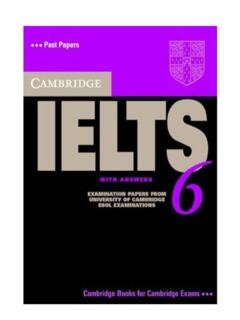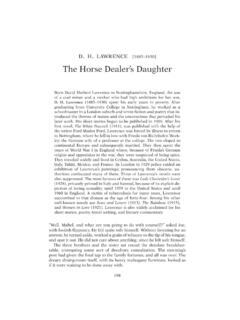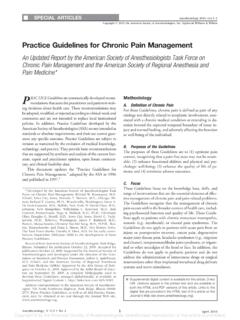Transcription of Longman Dictionary of Language Teaching and Applied
1 LongmanDictionary oFLANGUAGETEACHING&APPLIEDLINGUIsTICsJac k C. RichardsRichard schmidtFOURTHEDITIONMost CoMprehensive edition ever - 350 new entriesthis best-selling Dictionary is now in its 4th edition. specifically written for students oflanguage Teaching and Applied linguistics, it has become an indispensible resource for those engaged in courses in teFL, tesoL, Applied linguistics and introductory courses in general linguistics. this fully revised edition includes over 350 new entries. previous definitions have been revised or replaced in order to make this the most up-to-date and comprehensive Dictionary available. providing straightforward and accessible explanations of difficult terms and ideas in Applied linguistics, this Dictionary offers:l nearly 3000 detailed entries, from subject areas such as Teaching methodology, curriculum development, sociolinguistics, syntax and phonetics l Clear and accurate definitions which assume no prior knowledge of the subject matterl helpful diagrams and tables l Cross references, linking related subject areas for ease of reference The Dictionary of Language Teaching and Applied Linguistics is the definitive resource for oFLANGUAGETEACHING&APPLIEDLINGUIsTICsFOU RTHEDITIONR ichardsschmidtLongmanDictionary oFLANGUAGETEACHING& 17/4/10 15:41:31 Longman Dictionary ofLanguage Teaching and Applied Linguistics Longman Dictionary ofLANGUAGE Teaching ANDAPPLIED LINGUISTICSJack C.
2 Richards and Richard SchmidtFourth edition PEARSON EDUCATION LIMITEDE dinburgh GateHarlow CM20 2 JETel: +44 (0)1279 623623 Fax: +44 (0)1279 431059 Website: edition published 1985 Second edition published 1992 Third edition published 2002 Fourth edition published in Great Britain in 2010 Pearson Education Limited 1985, 1992, 2002, 2010 The rights of Jack C. Richards and Richard Schmidt to be identified as authors of this Work have been asserted by them in accordance with the Copyright, Designs and Patents Act Education is not responsible for the content of third party internet 978-1-4082-0460-3 British Library Cataloguing in Publication DataA CIP catalogue record for this book can be obtained from the British LibraryLibrary of Congress Cataloging in Publication DataA CIP catalog record for this book can be obtained from the Library of CongressAll rights reserved; no part of this publication may be reproduced, stored in a retrieval system, or transmitted in any form or by any means, electronic, mechanical, photocopying, recording, or otherwise without either the prior written permission of the Publishers or a licence permitting restricted copying in the United Kingdom issued by the Copyright Licensing Agency Ltd, Saffron House, 6-10 Kirby Street, London ECIN 8TS.
3 This book may not be lent, resold, hired out or otherwise disposed of by way of trade in any form of binding or cover other than that in which it is published, without the prior consent of the 13 12 11 10 Typeset in Sabon by 35 Printed in Malaysia (CTP-VVP) aphasianaphasicadjalso dysphasialoss of the ability to use and understand Language , usually causedby damage to the brain. The loss may be total or partial, and mayaffect spoken and/or written Language are different types of aphasia: agraphiais difficulty in writing;alexiais difficulty in reading; anomiais difficulty in using propernouns; and agrammatismis difficulty in using grammatical wordslike prepositions, articles, can be studied in order to discover how the brain processes alsoneurolinguisticscomputer assisted Language learning nalso CALLthe use of a computer in the Teaching or learning of a second or foreign Language . CALL may take the form ofaactivities which parallel learning through other media but whichuse the facilities of the computer ( using the computer topresent a reading text)bactivities which are extensions or adaptations of print-based or classroom based activities ( computer programs thatteach writing skills by helping the student develop a topic andthesis statementand by checking a composition for vocabu-lary, grammar, and topic development)
4 , andcactivities which are unique to also interactive videodysphasiananother term for aphasiaCALLnan abbreviation for computer assisted Language learningagrammatismnsee aphasiaGUIDE TO THE Dictionary entry for a word explained elsewhereentry for anabbreviationentry for a less common alternativeabbreviationfor termother relatedentries it may be useful to look upless commonalternativerelated wordpart of speechterm explained at its own alphabeticalentrytermsexplainedwithin the entry INTRODUCTIONWho is this Dictionary for?This Dictionary is intended for: students taking undergraduate or graduate courses in Language teachingor Applied linguistics, particularly those planning to take up a career inthe Teaching of English as a Second or Foreign Language or in foreign Language Teaching Language teachers doing in-service or pre-service courses, such as theUCLES Diploma in Teaching English to Adults students doing introductory courses in linguistics and related areas teachers and others interested in the practical applications of languagestudyWhy this Dictionary ?
5 Language Teaching and Applied linguistics are fields which have their owncore subject matter and which also draw on a number of complementaryfields of study. Among the core subject matter disciplines are second Language acquisition, methodology, testing, and syllabus design. The complementary fields of study include both the Language based disciplinessuch as linguistics, sociolinguistics, and psycholinguistics, as well as theeducation based disciplines such as curriculum development, teacher education, and evaluation. The result is that students taking courses in Language Teaching and Applied linguistics encounter a large number of specialized terms which frequently occur in articles, books and Dictionary attempts to clarify the meanings and uses of these scope of the dictionaryThe Dictionary was written for those with little or no background in Language Teaching or Applied have given special attention to English, and the majority of the examples in the Dictionary are from English, but the Dictionary will also behelpful to those interested in other languages.
6 Although the Dictionary isnot intended primarily for those who already have a specialized training inlanguage Teaching or Applied linguistics, it will serve as a reference book inareas with which they are less familiar. It should also be useful to generalreaders who need further information about the terms which occur in thefields of Language Teaching and Applied Language Teaching and Applied linguisticsThis Dictionary includes the core vocabulary of both Language Teaching andapplied linguistics. The field of Language Teaching is concerned with thedevelopment of Language programmes and courses, Teaching methodology,materials development, second Language acquisition theory, testing, teachertraining and related areas. The Dictionary includes terms from the followingareas of study in the field of Language Teaching : Teaching methods and approaches in Language Teaching curriculum development and syllabus design second Language acquisition the Teaching of listening, speaking, reading and writing computer assisted Language learning teacher education in Language Teaching English grammar and pronunciation Language testing, research methods, and basic statisticsThe Dictionary also includes terms from the field of Applied linguistics.
7 For the purposes of this book, Applied linguistics refers to the practicalapplications of linguistics and Language theory and includes terms from thefollowing areas of study: introductory linguistics, including phonology, phonetics, syntax, seman-tics and morphology discourse analysis sociolinguistics, including the sociology of Language and communicativecompetence psycholinguistics, including learning theoriesWhat the Dictionary containsThis Dictionary contains some 3500 entries, which define in as simple andprecise a way as possible, the most frequently occurring terms found in theareas listed above. Each term has been selected on the basis of its import-ance within an area and reflects the fact that the term has a particular meaning when used within that area, a meaning unlikely to be listed inother dictionaries. Many of these terms were included in the third edition ofthis Dictionary , but in preparing the fourth edition, a number of items nolonger in common use were delated, revisions were made to a number ofentries, and some 360 new entries have been added to reflect current usagein Language Teaching and Applied aim has been to produce clear and simple definitions which communi-cate the basic and essential meanings of a term in non-technical Definitions are self-contained as far as possible, but cross references showlinks to other terms and edition of the Dictionary has been prepared by Jack C.
8 Richards andRichard would like to thank those who contributed to earlier editions of this Dictionary , particularly Heidi Kendricks, who contributed to the first andsecond editions, the late John Platt, who contributed to the first and secondeditions, and the following who gave valuable suggestions to earlier editions:Christopher Candlin, John W. Oller (Jr), Lyle Bachman, Graham Crookes,Ken Hylands, Stephen Jacques; and Youngkyu Kim for assistance in thearea of testing, research design, and are grateful to Ms Media Shojaee for suggestions for new items to beincluded in the fourth 1 AAAAL nan abbreviation for American Association for Applied LinguisticsAAEnan abbreviation for African American EnglishAAVEnan abbreviation for African American vernacular Englishsee African American Englishability groupingnin Teaching , the placement of students in groups or classes according to their ability in a skill or subject, based on their Language containing students of different ability levels are known as mixedability groupsor heterogeneous groups, while groups composed of studentswith similar abilities, achievement, etc.
9 , are known as homogeneous groupingablautna process by which an inflected form of a word is formed by changes in thevowel of the stem. For example, the past tense of singis sangand the pluralof gooseis Language nsee indigenous languageabsolutenan adjective or adverb that cannot have a comparative or superlative form. For example perfectly and unique already express the idea of to a maximum degree and cannot therefore be used with comparative formsas in *most perfectly, or *more clause (phrase, construction)na non-finite adverbial clause or other adverbial construction that is notlinked syntactically to the main clause, far as I can tell, she is not having any problems with the nounnsee concrete noun ABX discriminationnin psycholinguistics, a task in which three stimuli are presented in a trial. A and B are different (for example, the words rampand lamp) and the subject s task is to choose which of them is matched by the discourse nthe Language and discourse of academic genres.
10 The study of academic discourse focuses on the nature, contexts, production and interpretation ofdiscourse and texts that occur in academic also ENGLISH FORACADEMICPURPOSES,GENRE,REGISTER academic Language nthe special registers and genres of Language used in the learning of academicsubject matter in formal schooling contexts. Learning academic Language isessential for mainstreamingsecond Language learners and for studentsstudyingEnglish for Academic literacy nthe ability to understand and participate in the academic discourse of academic genres, in fields such as science, law and literature, includingthe ability to produce and understand written and spoken texts as well asrecognizing the social norms and discursive practices of academic com-munities. The field of English for Academic Purposesseeks to developthe skills of academic vocabulary nthe most frequently occurring vocabulary in academic texts.







